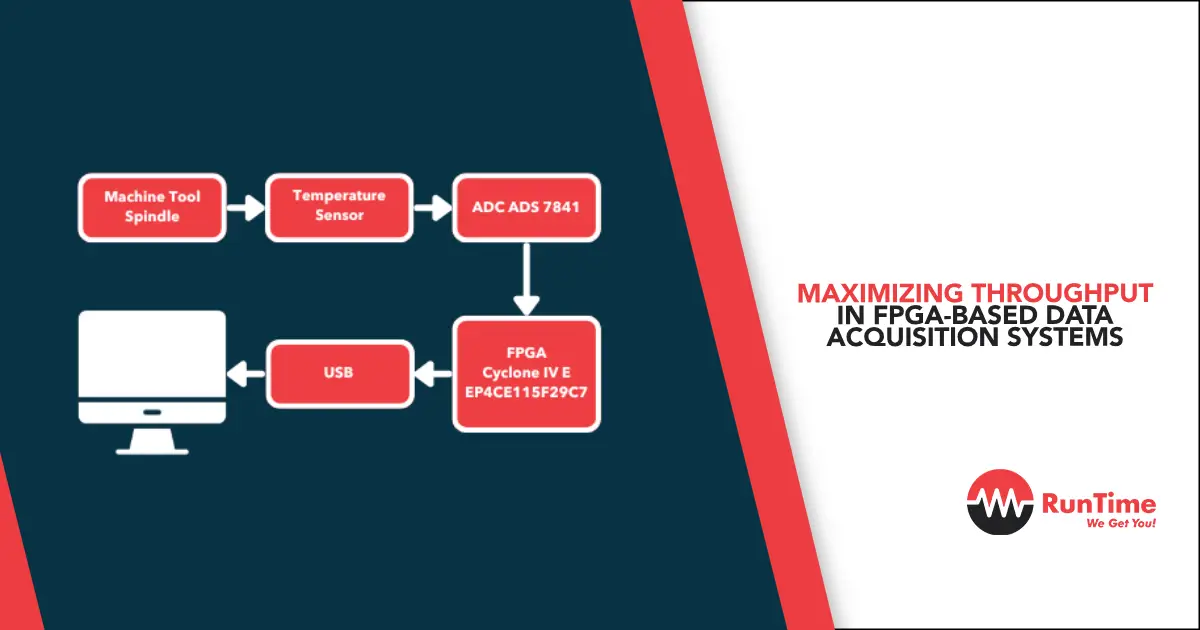Achieving peak performance in data acquisition systems relies on optimizing the utilization of cutting-edge technology, enhancing data processing speed and efficiency. Field-Programmable Gate Arrays (FPGAs) are known for their unmatched flexibility and speed, making them a preferred solution for implementing intricate data systems.
By refining FPGA design and operation, substantial improvements in system throughput can be realized, resulting in accelerated data transfer, processing, and response capabilities. These enhancements translate to heightened real-time performance, minimized latency, and improved overall operational effectiveness in data-centric applications.
Embracing advanced strategies like parallel processing, pipelining, and resource allocation is crucial for pushing the boundaries of data throughput in FPGA-driven systems. By prioritizing throughput optimization, professionals can fully unleash the power of FPGA technology, meeting the escalating demands for rapid data processing within contemporary computing landscapes.
Understanding Throughput in FPGA-Based Data Acquisition Systems
FPGAs (Field-Programmable Gate Arrays) have become integral components in data acquisition systems due to their ability to process data in parallel. One of the key performance metrics used to evaluate the efficiency of FPGA-based systems is throughput. In this section, we will delve into the concept of throughput in FPGA-based data acquisition systems, explore the factors that influence throughput, and discuss the barriers that may hinder achieving high throughput.
Explaining Throughput in FPGA Systems
Throughput, a critical metric in FPGA-based data acquisition systems, defines the rate at which data can be processed, transmitted, and stored within a specified timeframe. It plays a pivotal role in determining system performance, affecting tasks such as signal processing, data analysis, and real-time operations. Understanding the nuances of throughput is essential for optimizing FPGA systems to meet the demands of modern data-intensive applications.
Factors Influencing Throughput
The throughput of FPGA-based data acquisition systems is influenced by a multitude of factors that span hardware and software domains. These factors encompass the architectural design of the FPGA, the efficiency and complexity of implemented algorithms, the clock frequency driving the system, the data bus width facilitating data transfer, and the memory bandwidth supporting storage operations. By strategically optimizing these factors, developers can unlock the full potential of their FPGA systems, achieving enhanced throughput and improved overall performance.
Barriers to Achieving High Throughput
While high throughput is a desirable goal in FPGA-based data acquisition systems, several barriers can impede its attainment. These barriers range from resource limitations within the FPGA, suboptimal algorithmic implementations, constraints on data transfer rates, to bottlenecks within the system architecture. Overcoming these challenges demands a comprehensive understanding of system design, meticulous optimization strategies, and innovative solutions to unleash the maximum throughput capabilities of FPGA-based data acquisition systems.
Future Prospects and Innovations
Looking ahead, advancements in FPGA technology continue to drive innovations in data acquisition systems. Emerging trends such as the integration of AI accelerators, the adoption of high-speed interconnects, and the evolution of reconfigurable computing architectures are poised to revolutionize throughput capabilities. By staying abreast of these developments and embracing novel design methodologies, developers can harness the full potential of FPGAs, pushing the boundaries of throughput performance in data acquisition systems.
Importance of Maximizing Throughput
Enhancing Performance Efficiency
Maximizing throughput is crucial for enhancing performance efficiency in any system. By focusing on optimizing throughput, organizations can ensure that their systems are able to handle a higher volume of tasks within a given time frame. This leads to improved productivity and overall performance. Efficient throughput management can streamline operations, reduce bottlenecks, and enhance resource utilization, resulting in cost savings and improved ROI.
Impact on Data Processing Speed
High throughput directly impacts data processing speed. Systems with high throughput can process a larger amount of data in a shorter time, enabling real-time data processing and analysis. This speed is essential in today’s fast-paced digital world where timely decisions are crucial for success. Moreover, increased data processing speed can lead to quicker insights, faster decision-making, and improved responsiveness to changing market conditions.
Advantages of High Throughput Systems
High throughput systems offer numerous advantages. They can handle large-scale operations efficiently, support high user concurrency, and provide a seamless user experience. Additionally, such systems are better equipped to scale with growing demands, ensuring that performance remains consistent even as workloads increase. High throughput systems also contribute to better resource allocation, improved fault tolerance, and enhanced system reliability, making them indispensable for mission-critical applications.
Ensuring Scalability and Flexibility
Maximizing throughput not only boosts immediate performance but also ensures scalability and flexibility for future growth. Systems designed with high throughput in mind are inherently more adaptable to changing requirements and increased workloads. This adaptability is crucial in dynamic business environments where rapid expansion or shifts in demand can occur. By investing in high throughput systems, organizations future-proof their infrastructure and minimize the need for frequent system overhauls.
Enhancing Customer Satisfaction
One often-overlooked benefit of maximizing throughput is its positive impact on customer satisfaction. High throughput systems can deliver faster response times, reduced latency, and seamless user interactions, leading to enhanced customer experiences. Where customer expectations are constantly rising, providing a responsive and reliable service can set businesses apart from their competitors. By prioritizing throughput optimization, organizations can not only meet but exceed customer expectations, fostering loyalty and positive brand recognition.
Maximizing throughput is a multifaceted strategy that goes beyond mere speed improvements. It is a fundamental aspect of performance optimization that influences efficiency, speed, scalability, flexibility, and customer satisfaction. Organizations that recognize the importance of throughput maximization position themselves for sustained success in an increasingly data-driven and competitive market environment.
Strategies for Enhancing Throughput
Optimizing FPGA Designs for Throughput
In the realm of digital design, Field-Programmable Gate Arrays (FPGAs) offer a flexible platform for creating custom hardware solutions. To enhance throughput, it is crucial to optimize FPGA designs by leveraging techniques such as pipelining, parallel processing, and resource utilization. This optimization process involves carefully crafting the design to make efficient use of the available hardware resources while meeting performance requirements. One key aspect of optimizing FPGA designs is to consider the architecture of the FPGA itself. Understanding the internal structure of the FPGA and its components allows designers to maximize performance by effectively utilizing the available resources. Furthermore, by employing tools like high-level synthesis (HLS), designers can abstract the low-level hardware details and focus on optimizing the algorithmic aspects of the design, leading to improved throughput.
Utilizing Parallel Processing Techniques
Parallel processing is a powerful strategy for improving throughput in computing systems. By breaking down tasks into smaller sub-tasks that can be executed simultaneously, parallel processing can significantly boost performance. When applied to FPGA designs, parallel processing techniques like parallelism at various levels (data, task, instruction) can help in achieving higher throughput by enabling multiple operations to be executed concurrently. Additionally, the use of advanced parallel processing architectures like systolic arrays or SIMD (Single Instruction, Multiple Data) can further enhance throughput by exploiting data-level parallelism and reducing latency. By carefully designing the parallelization strategy based on the nature of the algorithm and the available hardware resources, designers can achieve optimal throughput performance.
Implementing Data Compression Methods
Data compression plays a vital role in enhancing throughput by reducing the amount of data that needs to be processed or transmitted. By implementing data compression methods in FPGA designs, such as lossless or lossy compression algorithms, designers can effectively reduce the size of data streams, leading to faster processing and improved throughput. Careful consideration must be given to the trade-offs between compression ratios, processing overhead, and the specific requirements of the application to choose the most suitable compression technique for optimizing throughput. Moreover, emerging technologies like hardware-accelerated compression units or custom compression IP cores can be integrated into FPGA designs to offload compression tasks and further improve overall system throughput. By combining efficient data compression techniques with parallel processing strategies and optimized FPGA designs, designers can achieve significant enhancements in system throughput and performance.
Real-world Applications and Success Stories
Practical Uses of High Throughput FPGA Systems
- Accelerating Cryptocurrency Mining: Harnessing the power of high-throughput FPGA systems to enhance the efficiency and speed of cryptocurrency mining operations, leading to increased profitability and scalability within the blockchain industry. FPGA technology allows miners to process complex cryptographic algorithms with greater speed and energy efficiency compared to traditional CPU or GPU setups, resulting in higher mining rewards and reduced operational costs.
- Medical Imaging Advancements: Utilizing FPGA systems for high-speed processing of medical imaging data, leading to quicker diagnoses, improved patient outcomes, and advancements in medical technology. The ability of FPGA systems to handle complex algorithms in real-time significantly impacts the healthcare sector by improving accuracy and reducing diagnosis time. Additionally, FPGA-based medical imaging devices can provide real-time image enhancement and analysis, aiding healthcare professionals in making critical decisions swiftly and accurately.
- Autonomous Vehicles Development: Incorporating high-throughput FPGA systems in autonomous vehicles for real-time data processing and decision-making, enhancing safety, efficiency, and paving the way for the widespread adoption of autonomous driving technology. FPGA systems play a crucial role in enabling vehicles to perceive the environment, make split-second decisions, and navigate complex scenarios with precision. The use of FPGAs in autonomous vehicles not only improves reaction times but also contributes to the development of advanced driver-assistance systems that enhance overall road safety.
Examples of Successful Throughput Optimization
- Financial Trading Platforms: Implementing high-throughput FPGA systems to optimize trading algorithms and execute trades with minimal latency, resulting in competitive advantages and increased profitability for financial institutions. The speed and accuracy provided by FPGA systems are paramount in high-frequency trading environments where every millisecond counts. Furthermore, FPGA-based trading platforms can adapt to rapidly changing market conditions and execute trades with precision, ensuring optimal outcomes for traders and investors.
- Internet Data Centers: Enhancing data processing speeds in internet data centers through the use of FPGA systems, improving overall network performance, reducing latency, and ensuring seamless user experiences. FPGA technology enables data centers to handle increasing volumes of data efficiently and maintain the responsiveness of online services. By offloading specific computational tasks to FPGAs, data centers can achieve higher throughput rates, lower power consumption, and better resource utilization, resulting in enhanced service reliability and customer satisfaction.
- High-Frequency Trading: Leveraging FPGA systems to achieve high-throughput data processing in high-frequency trading environments, enabling rapid decision-making and execution to capitalize on market opportunities swiftly. The ultra-low latency offered by FPGA systems is instrumental in executing trades at optimal prices and gaining a competitive edge in dynamic financial markets. FPGA-based trading strategies can analyze market data in real-time, identify profitable trading opportunities, and execute orders with minimal delay, ensuring traders can react swiftly to market changes and maximize their returns.
These real-world applications and success stories showcase the diverse ways in which high-throughput FPGA systems are revolutionizing industries, driving innovation, and shaping the future of technology. From enhancing computational power to enabling real-time processing, FPGA systems continue to redefine possibilities and unlock new opportunities across various sectors. The versatility and scalability of FPGA technology make it a cornerstone of modern computing, empowering businesses and researchers to push the boundaries of what is achievable in fields ranging from finance and healthcare to transportation and communications.
Overcoming Challenges in Throughput Maximization
In the realm of data processing and networking, achieving optimal throughput is crucial for ensuring efficient operations and seamless user experiences. However, various challenges often hinder throughput maximization efforts. In this section, we will delve into key strategies and techniques for overcoming these obstacles and enhancing overall throughput.
Addressing Bottlenecks in Data Transfer
Data transfer bottlenecks can significantly impede throughput, leading to delays and inefficiencies in data processing. Identifying and addressing these bottlenecks is essential for optimizing throughput. Techniques such as optimizing network configurations, upgrading hardware components, and implementing data compression algorithms can help alleviate bottlenecks and improve data transfer speeds.
Mitigating Latency Issues
Latency issues can have a detrimental impact on throughput, especially in real-time data processing scenarios. By implementing latency reduction strategies such as caching frequently accessed data, utilizing content delivery networks (CDNs), and employing efficient routing protocols, organizations can minimize latency and enhance overall throughput performance.
Strategies for Load Balancing
Effective load balancing is paramount for distributing network traffic evenly across servers and resources, preventing overloads and maximizing throughput capacity. Implementing load balancing algorithms, utilizing scalable infrastructure resources, and employing dynamic load balancing mechanisms can help organizations achieve optimal throughput levels and ensure reliable performance under varying workloads.
Ensuring Data Security in Throughput Optimization
Securing data during high throughput operations is critical to prevent breaches and maintain data integrity. Encryption protocols, secure data transfer methods, and regular security audits are essential for safeguarding sensitive information and ensuring compliance with data protection regulations.
Harnessing the Power of Parallel Processing
Parallel processing techniques can significantly enhance throughput by dividing tasks into smaller sub-tasks that can be processed simultaneously. Utilizing parallel processing frameworks, distributing computational workloads efficiently, and optimizing task allocation can boost throughput performance and expedite data processing.
Continuous Performance Monitoring and Optimization
Monitoring throughput performance metrics in real-time and proactively identifying performance bottlenecks is key to maintaining optimal throughput levels. Implementing automated performance monitoring tools, conducting regular performance audits, and fine-tuning system configurations based on performance data analysis can help organizations continuously optimize throughput efficiency.
By addressing bottlenecks in data transfer, mitigating latency issues, implementing robust load balancing strategies, ensuring data security, harnessing parallel processing capabilities, and continuously monitoring and optimizing performance, organizations can overcome challenges in throughput maximization and elevate the efficiency and reliability of their data processing and networking operations.
Future Trends and Innovations in FPGA Systems
Emerging Technologies Shaping Throughput
The field-programmable gate array (FPGA) technology is constantly evolving, driven by emerging technologies that are shaping the landscape of digital systems. From advancements in AI and machine learning to the rise of edge computing, FPGAs are at the forefront of enabling high-throughput processing with low latency. This section explores the key emerging technologies influencing FPGA systems and how they are enhancing throughput in various applications.
Predictions for the Evolution of Data Acquisition Systems
As data acquisition systems become more complex and demanding, there is a growing need for innovative solutions that can keep up with the increasing data volumes and processing requirements. FPGAs are expected to play a crucial role in the evolution of data acquisition systems, offering customizable and high-performance solutions for data processing, analysis, and storage. This section delves into the future trends and predictions for how FPGA systems will shape the next generation of data acquisition systems.
The Impact of 5G on FPGA Systems
With the rollout of 5G networks worldwide, the demand for high-speed data processing and low-latency communications has surged. FPGAs are uniquely positioned to address the requirements of 5G infrastructure by providing flexible and scalable hardware acceleration for tasks such as signal processing, encryption, and network optimization. This section examines how FPGA systems are adapting to the challenges and opportunities presented by the widespread implementation of 5G technology.
Advancements in Quantum Computing and FPGAs
As the field of quantum computing continues to advance, there is a growing interest in harnessing the power of FPGAs to enhance quantum processing capabilities. FPGAs offer a versatile platform for implementing quantum algorithms, optimizing quantum circuits, and interfacing with quantum hardware. This section explores the intersection of quantum computing and FPGA systems, highlighting the potential synergy between these cutting-edge technologies and their implications for future computing architectures.
The Rise of Edge AI and FPGA Acceleration
Edge AI, which involves deploying AI algorithms directly on edge devices, is revolutionizing the way data is processed and analyzed at the network periphery. FPGAs play a pivotal role in enabling efficient and low-power AI inferencing at the edge, offering real-time data analytics and decision-making capabilities. This section investigates the convergence of edge AI and FPGA acceleration, showcasing how FPGA systems are driving innovation in intelligent edge computing applications and paving the way for autonomous systems with enhanced processing capabilities.
Conclusion
Maximizing throughput in FPGA-based data acquisition systems is crucial for achieving high performance and efficiency in data processing applications. By carefully designing and optimizing the hardware architecture, implementing parallel processing techniques, and utilizing advanced algorithms, it is possible to significantly enhance the throughput capabilities of FPGA-based systems. This can lead to improved data acquisition speeds, reduced latency, and overall enhanced system performance, making FPGA technology a promising choice for demanding data processing tasks. By leveraging the full potential of FPGAs, developers can unlock new possibilities in various fields such as telecommunications, image processing, and scientific research.









